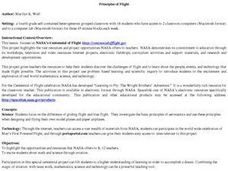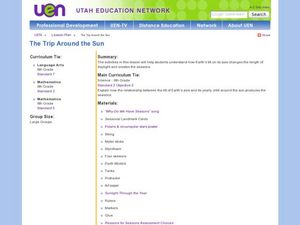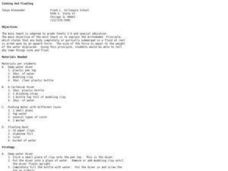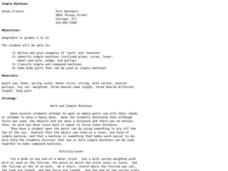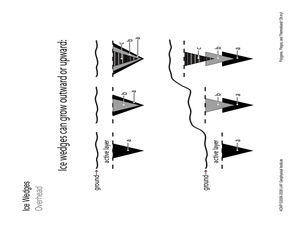Curated OER
Levers and Wedges in the Human Body
Young biologists identify parts of the body that serve as wedges (teeth and fingernails), and as levers (jaw, arms, and legs). The hands-on activities described here should be exciting for learners to perform, and should also lead to a...
Curated OER
Making and Using a Gel Person to Teach Human Anatomy
Students investigate organs, anatomical planes and transverse sections of the human body using gel people. In this human anatomy lesson plan, students use gel molds, gel and food items to make models of the human body. They create a...
Purdue University
The Represented World: Recreational STEM
How are forces and motion important to a swing set? Scholars explore the concepts of force and motion using swing sets. In preparation for their own STEM design project, individuals take surveys and data from peers, complete labs on...
Cornell University
Buoyancy
Swimmers know to float by turning their bodies horizontally rather than vertically, but why does that make a difference? In an interesting lesson, scholars explore buoyancy and the properties of air and water. They test cups to see which...
Curated OER
Learning the Dissecting Planes
Students explore dissecting planes. In this biology lesson plan, students learn the basic vocabulary used in dissection, learn how to orient themselves on a three dimensional figure, and develop the manual dexterity necessary to use...
Curated OER
Why Do We Have Seasons?
First graders watch a video about the seasons. They role play with the teacher the sun and earth. The student's heads are the earth, their foreheads are the Northern Hemisphere. The teacher shines a flashlight on them to simulate the sun...
Curated OER
Simple Machines
Students investigate simple machines. In this simple machines lesson, students explore how tools increase productivity and make life easier. Students experiment with simple tools and discover the parts of each tool.
Curated OER
Dayna Lykins, Leanna Prater
Fourth graders compare and contrast gliding flight and true flight. They investigate the basic principles of aeronautics. The class participates in activities to observe lift and the effect of air. Students design and fly their own...
Hawaiʻi State Department of Education
Machines
What do science and dance have in common? Simple machines, work, and force! First, children discuss machines, wheels, inclined planes, and wedges. They create inclined planes with their bodies and make up dances about wheels and wedges....
Curated OER
The Trip Around the Sun
Sixth graders investigate the relationship between the tilt of the Earth's axis and the seasons. In this earth science lesson plan, 6th graders sing the song "Why Do We Have Seasons" and use simulate the Earth's tilt by using their bodies.
California Academy of Science
Kinesthetic Astronomy: Mars Opposition Dance
Your class will watch as one child orbits the sun as Earth, while another orbits as Mars. If the timing is right, they will see the repetitive dance between the two planets and discover how often they are opposite from each other. For...
Curated OER
Let's Think About... Magnets and Gravity
Students watch an episode of the PBS show "Jay Jay the Jet Plane," and explore magnets and gravity. They conduct various experiments involving magnets and sand, bean bags, and a fishing pole with magnets.
Curated OER
Rotational Inertia
Young scholars spin themselves to understand rotational inertia. In this Inertia lesson, students will also use ramps, balance beam and pendelum to conduct rotational inertia experiments. Young scholars draw conclusions to explain...
Curated OER
Term Paths
Young scholars follow several pathways using anatomical directions on a simulated "body" produced from a copy of a school building's fire evacuation plan.
Curated OER
Sinking and Floating
Students examine why some objects float or sink. In this physics instructional activity, students engage in several mini-experiments which challenge them to draw their own conclusions regarding why certain objects sink or float. An...
Curated OER
Animal Morphs
Students explore animal drawing. In this cross curriculum drawing, photography, and animals lesson, students combine computer drawing and freehand drawing to create an animal and its environment using a photograph of their own face...
Curated OER
Exploring Meteorite Mysteries: Building Blocks of Planets
Students simulate the formation of chondrites and asteroids. In this astronomy lesson, students demonstrate accretion using balloons and static electricity. They compare and contrast their models to the actual process of chondrites and...
Curated OER
Simple Machines
Students investigate what simple machines are and how they work. In this simple machine lesson, the students create simple and compound machines and test each machine's ability to perform a task. Students compare simple machines to...
Curated OER
A Moon with a View
Third graders explore the rotation of Earth and the moon. In this solar system activity, 3rd graders participate in an Earth and moon simulation in which part of the class "becomes" the sun, while other children represent the moon by...
Curated OER
Polygons, Pingos, and Themokarst! Oh MY!
Students complete activities to learn about the common land features in Alaska. In this land study instructional activity, students study an overhead for permafrost features. Students define ice wedge polygons, thermokarst, and pingos....
Curated OER
Unit 2 Sun & Stars
Students describe stellar objects using terms such as stars, planets, satellites, orbits and light. In this sun and stars unit, students research stellar objects through seven individual lessons discovering star characteristics, how...
Curated OER
Methods of Heat Transfer
Eighth graders discuss the forms of heat transfer that relate to the human body. Discussion revolves around the ability of different designs of hats to change the rate of heat transfer to and from the body. Students then experiment...
Curated OER
Exploring Simple Machines
Students investigate simple machines. In this simple machines lesson, students study how simple machines work. Students determine the function of various simple machines.
Curated OER
What Can You Make of It?
Students investigate the various uses of a paper cup. In this scientific inquiry instructional activity, students investigate various ways to use a paper cup by identifying its characteristics. Students sketch their discovery.









